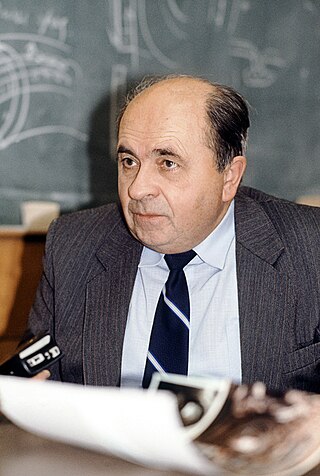Related Research Articles

Harold Paul Furth was an Austrian-American physicist who was a pioneer in leading the American efforts to harness thermonuclear fusion for the generation of electricity. He died of a heart ailment on 21 February 2002.
The James Clerk Maxwell Prize for Plasma Physics is an annual American Physical Society (APS) award that is given in recognition of outstanding contributions to the field of the Plasma Physics. It was established in 1975 by Maxwell Technologies, Inc, in honor of the Scottish physicist James Clerk Maxwell. It is currently sponsored by General Atomics. The prize includes a $10,000 USD monetary award and recognition at the annual American Physical Society Division of Plasma Physics conference.

Charles F. Kennel is an American plasma physicist and former Associate Administrator of NASA. He is an elected member of the National Academy of Sciences and won the James Clerk Maxwell Prize for Plasma Physics in 1997. In 2009, he was advertised by NASA Watch as a potential pick by Barack Obama as the next NASA Administrator.
John Myrick Dawson was an American computational physicist and the father of plasma-based acceleration techniques. Dawson earned his degrees in physics from the University of Maryland, College Park: a B.S. in 1952 and Ph.D. in 1957. His thesis "Distortion of Atoms and Molecules in Dense Media" was prepared under the guidance of Zaka Slawsky.
Ignitor is the Italian name for a proposed tokamak device, developed by ENEA. The project was abandoned in 2022.

Richard Freeman Post was an American physicist notable for his work in nuclear fusion, plasma physics, magnetic mirrors, magnetic levitation, magnetic bearing design and direct energy conversion.
John Bryan Taylor is a British physicist known for his contributions to plasma physics and their application in the field of fusion energy. Notable among these is the development of the "Taylor state", describing a minimum-energy configuration that conserves magnetic helicity. Another development was his work on the ballooning transformation, which describes the motion of plasma in toroidal (donut) configurations, which are used in the fusion field. Taylor has also made contributions to the theory of the Earth's Dynamo, including the Taylor constraint.
Ronald Crosby Davidson was a Canadian physicist, professor, and scientific administrator who worked in the United States. He served as the first director of the MIT Plasma Science and Fusion Center from 1978 to 1988, and as director of the Princeton Plasma Physics Laboratory from 1991 to 1996. He had been Professor of Astrophysical Sciences at Princeton University since 1991.
John Morgan Greene was an American theoretical physicist and applied mathematician, known for his work on solitons and plasma physics.
Edward Allan Frieman was an American physicist who worked on plasma physics and nuclear fusion. He was the director of the Scripps Institution of Oceanography from 1986 through 1996, and then the senior vice president of science and technology at the Science Applications International Corporation from 1996 on until his death in 2013.

Harold Grad was an American applied mathematician. His work specialized in the application of statistical mechanics to plasma physics and magnetohydrodynamics.
Norman Rostoker was a Canadian plasma physicist known for being a pioneer in developing clean plasma-based fusion energy. He co-founded TAE Technologies in 1998 and held 27 U.S. Patents on plasma-based fusion accelerators.
Miklos Porkolab (born March 24, 1939) is a Hungarian-American physicist specializing in plasma physics.
Tihiro Ohkawa was a Japanese physicist whose field of work was in plasma physics and fusion power. He was a pioneer in developing ways to generate electricity by nuclear fusion when he worked at General Atomics. Ohkawa died September 27, 2014, in La Jolla, California, at the age of 86.
Roy Walter Gould was an American electrical engineer and physicist who specialized in plasma physics. In 1959, he was the first to describe electrostatic waves that were propagating at the boundary of a magnetized plasma column, now commonly known as Trivelpiece–Gould modes.
Nathaniel Joseph Fisch is an American plasma physicist known for pioneering the excitation of electric currents in plasmas using electromagnetic waves, which was then used in tokamak experiments. This contributed to an increased understanding of plasma wave–particle interactions in the field for which he was awarded the James Clerk Maxwell Prize for Plasma Physics in 2005 and the Hannes Alfvén Prize in 2015.
Dmitri Dmitriyevich Ryutov is a Russian theoretical plasma physicist.
Ravindra Nath Sudan was an Indian-American electrical engineer and physicist who specialized in plasma physics. He was known for independently discovering the whistler instability in 1963, an instability which causes audible low-frequency radio waves to be emitted in the magnetosphere in the form of whistler waves. He also pioneered the study of the generation and propagation of intense ion beams, and contributed to theories of plasma instabilities and plasma turbulence.
John D. Lindl is an American physicist who specializes in inertial confinement fusion (ICF). He is currently the chief scientist of the National Ignition Facility at the Lawrence Livermore National Laboratory.

Boris Borisovich Kadomtsev was a Soviet and Russian plasma physicist who worked on controlled fusion problems. He developed a theory of transport phenomena in turbulent plasmas and a theory of the so-called anomalous behavior of plasmas in magnetic fields. In 1966, he discovered plasma instability with trapped particles.
References
- ↑ MIT News 2010 on the Ignitor Program
- ↑ "1987 James Clerk Maxwell Prize for Plasma Physics Recipient". American Physical Society. Archived from the original on 2011-05-16. Retrieved 2020-02-15.
- ↑ "List of academicians of the National Virgilian Academy". Archived from the original on 2022-05-24. Retrieved 2022-06-11.
- ↑ "Le onorificenze della Repubblica Italiana". www.quirinale.it. Retrieved 2020-02-15.
- ↑ "Jean Bourgain Wins 2016 Antonio Feltrinelli International Prize". Institute for Advanced Study. 10 June 2016. Retrieved 2020-02-15.